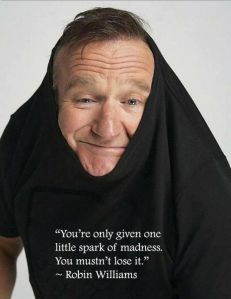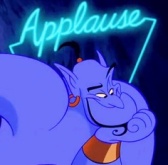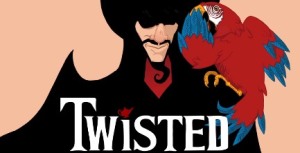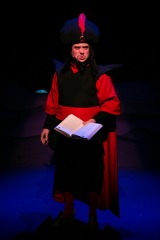As The Cowsills sang:
Gimme a head with hair, long beautiful hair. Shining, gleaming, streaming flaxen waxen..
Something I’ve noticed recently is the use of hair as a story-telling element for women and girls, especially in animation. This is nothing new. Hair has always been linked, one way or another, to societal position, marital status, and even rebellion, but in the visual format of film, television, and animation, hair has become the most visceral way of showing a person’s state of mind. The most recent example of this is a pivotal moment in Disney’s Frozen (2013) where Elsa, the Snow Queen, finally lets go of her repression and literally lets her hair down as she sings about embracing her true self.

No longer in the tight braid of suppression, Elsa now has a mussed up, slightly sexier braid, to say nothing of the dress she magically creates for herself with her ice-tailoring powers. The point is that this is supposed to be the moment Elsa completely comes into her own and it’s entirely linked to her hair. The minute that braid comes down, the audience immediately understands what’s just happened even if they’re not paying attention to the lyrics of the song. It’s a visual representation of Elsa’s state of mind that anyone can deduce.
Elsa, in this regard, actually has a lot in common with Merida from Brave (2012). Much of the movie’s early advertisements centered around how different Merida looked from other Disney princesses with her wild, curly red hair. The film even uses her hair to emphasize her rebellious spirit when Merida’s father, King Fergus, stands in as his daughter for a bit of role-playing to help his wife try to find an angle of communication. The king, in his best high-pitched voice proclaims, “I don’t want to get married, I want to stay single and let my hair flow in the wind as I ride through the glen firing arrows into the sunset.” Merida’s hair is linked to her desire for freedom from the responsibilities of marriage and being a princess. When she’s tied into her dress and her hair is stuffed into a wimple before her three suitors begin the series of games meant to win her as a bride, we’re meant to sympathize with her and her unwinnable situation. But when this happens…

It’s meant to be a moment of shock for the characters within the movie, but a triumphant moment for the audience and their attachment to Merida. The reveal of Merida’s unruly hair is an act of defiance, a statement of her intentions to be her own person by shooting for her own hand. Her feminist visualization goes even further when she breaks the stitching of her dress to give herself the proper freedom of movement to shoot her arrows, but her wild hair is the first and most obvious “moment” where Merida makes her intentions clear. The entire scene screams “METAPHOR!” but it sets the tone for Merida as a character and drives the central plot of the movie, more or less.
Disney actually uses hair in many of their animated movies as a means of visually depicting how the audience should perceive their female characters. This starts happening more during the Disney Renaissance since Snow White, Cinderella, and Aurora don’t have any hair-related incidents as visual cues tied to their character development. The closest would probably be after Cinderella’s step-sisters tear her dress apart and her hair is disheveled only to be done up regally when the Fairy Godmother provides her with a new outfit. It doesn’t do much for Cinderella as a person, but it shows what a state of mess she’s in before her wish is granted and she’s off to the ball.
Hair becomes a prominent feature starting with The Little Mermaid (1989) when the animation department showed off their skills at depicting hair underwater through the long, red locks of Ariel. Her hair practically has a will of its own as it shifts and falls with the current or Ariel’s movements, emphasizing her rebellious and youthful spirit in contrast to her six older sisters who either have their hair cut shorter or done up in a ponytail or bun. In Beauty and the Beast (1991), Belle’s hair continually transforms from the bookish, yet youthful ponytail to her hair worn down as she matures in her love for the Beast or when she’s in peril. A constant tick is Belle pushing a stray lock of hair away from her face, which always seems to coincide with a major revelation she has. In Aladdin (1992), Jasmine wears her hair in a hanging, segmented ponytail, yet her only major hair change comes when Jafar makes her a slave-girl, using the higher ponytail to symbolize her change in status.
Disney doesn’t entirely have a monopoly on hair as visual signifier. The other contender would be Nickelodeon’s Avatar: The Last Airbender (2005-2008) and The Legend of Korra (2012-present). In both shows, hair is used to signify the mental state and/or maturity of three characters specifically. Katara, over the course of three seasons (though only a year has passed in the world), transitions from her pulled back and braided hair on a near regular basis to consistently having it free flowing. In the first season, we only see it down when she means serious business and displays her mastery of waterbending, but in the later seasons it becomes a sign of her character growth and maturity. There are similarities in Legend of Korra in regards to the titular character. Korra, because of her athletic training, keeps her hair up, but in both the first and second season finales, when she has to fully display her skills as the Avatar, her hair always manages to come undun. By having her hair wild and free, it shows that Korra is equally as unrestrained.

The award for hair as linked to mental stability goes to Azula in Avatar: The Last Airbender. When we first meet Azula, she goes through a near perfect firebending routine, marred only by a single strand of hair out of place. The intensity with which Azula stares at the errant hair tells you everything you need to know about her. Her bullying and perfectionism come to a head when, devoid of all friends and allies, she awaits her crowing as the Fire Lord and breaks down in the process. Believing everyone is against her or trying to kill her, Azula tries to do her own hair, but messes it up. Her solution to the problem of such uncooperative hair is to frantically cut it. From there on out, she wears her hair down, uneven and disheveled. Her madness is solidified when she faces Zuko in Agni Kai. Her very movements become disturbing and erratic, made all the more so by her uncharacteristically free-flowing hair giving her a demonic presence as she attacks Zuko and Katara with uncontrolled glee.

Azula cutting her hair, however, does bring up an interesting contrast when it comes to Disney and its female leads. In most of their movies, the hair of each Disney princess has only changed in terms of how they wear it. There are two princesses, though one actually isn’t a princess but gets lumped into the category anyway, who have significant moments tied to their hair because it gets cut. It’s not as psychologically damaging, but important to their character’s nonetheless. The first is Mulan (1998). In order to take her father’s place in the Chinese army, Mulan needs to pass as a boy, leading to a very well done scene in which she cuts her long hair and takes her father’s armor, sword, horse, and summons. It’s a significant moment for Mulan not just as a woman, but as a woman in China. The men of China also have hair long enough to put in a topknot, so Mulan cutting her hair is more of a symbolic gesture, removing her duties as a daughter to assume the duties of a son to maintain the honor of her family. Though the Disney merchandise continues to depict her with the long hair she sports in the beginning of the first film, Mulan keeps her hair shorter even in the direct-to-DVD sequel, showing that her femininity and her prowess as a warrior lies in more than just her hair.
The second princess to have a significant hair cut is Rapunzel. In Tangled (2010), Rapunzel’s magical hair is attached to her freedom, though she doesn’t realize this until the climax of the film. Stolen away by Mother Gothel to continue rejuvenating her looks, Rapunzel’s hair cannot be cut or it will lose it’s magical properties. Though Gothel assumes the role of a parental figure, her primary focus is retaining her youth. To ensure that Rapunzel and her hair are never discovered, she warps the girl’s perception of the outside world as a means of keeping her in the tower. Her hair makes Rapunzel Gothel’s unwitting prisoner. When Flynn, who’s dying of stab wound, cuts her hair, he frees her from Gothel and her imprisonment at the cost of his own life. But this is a Disney movie, so you know that doesn’t stick for very long, right? Either way, when Rapunzel’s hair is cut, she’s finally free to be her own person and pursue her new dream. In many ways, it’s similar to real life.

Outside of animated movies, when a woman gets her hair cut, it’s an emotional ordeal that signifies transition or sacrifice. When Jo sells her hair in Little Women (1994) to pay for her mother’s train ticket or when Lt. Jordan O’Neill shaves her head to show her commitment to the Navy SEALS in G.I. Jane (1997), these are moments that show how far these women are willing to go to help others or to help themselves. Then there are instances like Sabrina’s maidenly and naive maturation into a sophisticated and worldly woman in Sabrina (1995) or Rebecca Warner changing from the timid farm girl into a “mature” college student in Son in Law (1993) that are emphasized through their hair going from long to short. Seems like the 90s were really into hair as metaphor.
If you’d like a more recent example of a live action movie hair transition, look no further than the upcoming Captain America 2: The Winter Soldier. Black Widow/Natasha Romanov (Scarlett Johansson), in three movies, has gone through three different hairstyles. In Iron Man 2 (2010), she had the long, curly sexy hair that was about as functional as her role in the movie. In The Avengers (2012), she had a wavy, short cut that showed her no nonsense, yet still feminine approach to being a spy and soldier. And in Cap 2, she now has shoulder length, straight hair. Character maturity or a typical Hollywood change up? You decide.

 magic of laughter.
magic of laughter.





